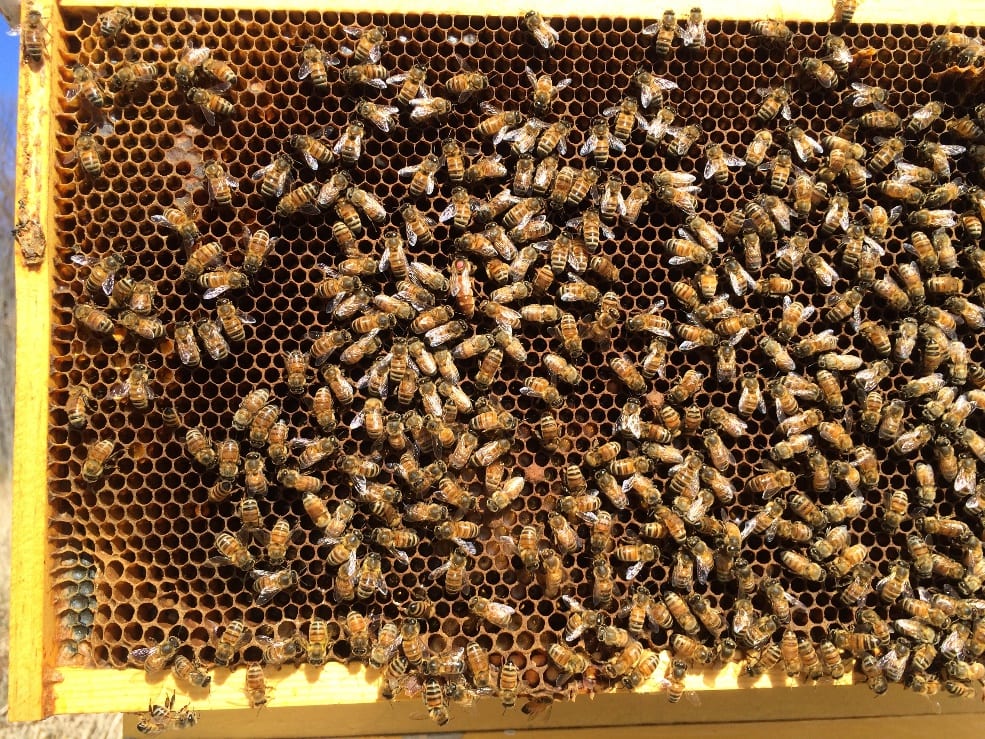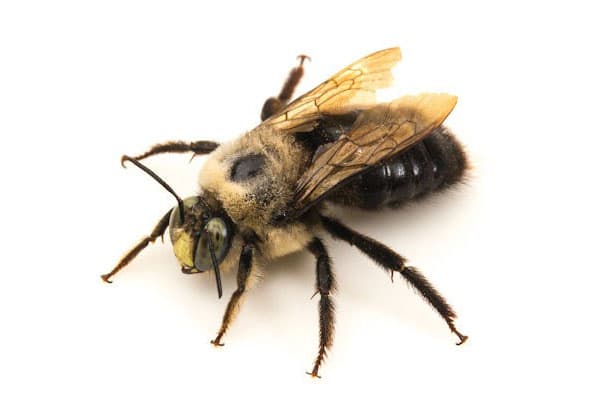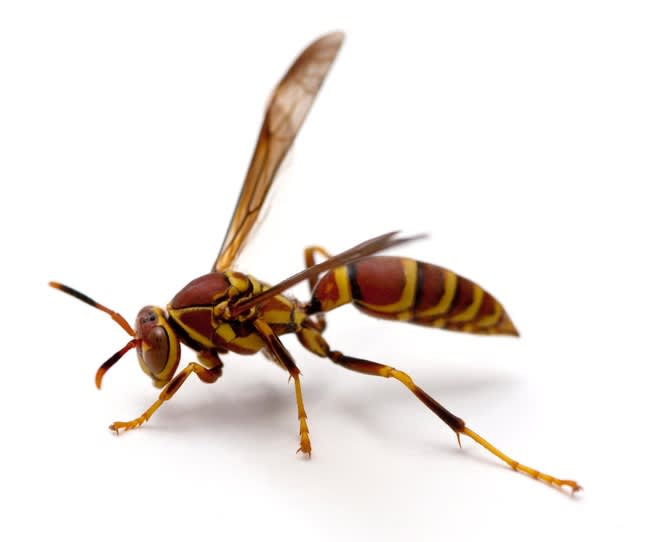Honey Bee
The common Western Honey Bee (Apis Mellifera) is more than likely very familiar to anyone living in North America. These bees are our primary pollinators for about a third of the United States food production, and wild honey bees can be found in every state. Honey bees are fuzzy with a golden brown hue and black stripes with the rear of the bee typically being oval shaped.
Bees can make their homes in a variety of places. Any enclosed space is a prime location for honeybees to start construction on their hives. Some common places you can find honey bee hives are in water meter boxes, under or inside the eaves of a house, and in hollowed out trees. The structure is made out of densely packed wax that the worker bees create with their own bodies early on in their life cycle. Bees construct their hives for maximum efficiency by shaping the individual cells in a hexagonal pattern. This forms the familiar honeycomb shape that we all know. This construction is so efficient that one pound of wax comb can hold up to ten pounds of honey.
A natural beehive can grow large enough to weigh approximately 110 pounds and be made-up of 60,000 individual bees. Hives built out in the open on trees or under exposed eaves are not sustainable in colder climates but can survive in the southern states like Texas, California, Florida. However, hives built in the heat like a hot attic or in the desert will melt since they are made out of wax that melts between 99-145°F.
In a honey bee colony there are 3 types of bees. The most common is the worker bee, making up over 95% of the hive population. Worker bees are female honey bees, although with limited reproductive capacity. As their name implies, worker bees do almost all of the maintenance, construction, and provide the basics of the hive. What a worker bee’s job is depends on what time in its life cycle it is in. Towards the beginning of their life worker bees will tend to stay in the hive, caring for and feeding larvae, cleaning cells, and constructing the comb. After the worker bee is about 3 weeks old, its main job will be foraging for food, including nectar and pollen. Worker bees can fly over a mile away from the hive for a food source.
The second type of bee in a typical honey bee colony are drones. Drones are male bees hatched from unfertilized eggs. Drone bees rely on worker bees to feed them and only provide one function to the colony: mating with the queen. While a drone can live up to 90 days, the act of mating with the queen will effectively kill them by rupturing their internal organs. Drone bees also lack the ability to sting and are characterized by a larger body than the workers, and large dome shaped eyes for finding the queen.

This leads us to the most important bee in the colony, the Queen Honey Bee. A lot of people wonder how you can tell the difference between a queen and the other bees; at a quick glance a buzzing hive will look very uniform to the untrained eye. For example, can you spot the queen in the picture to the right?
This queen is easy to spot (slightly up and left of the center) because it’s been marked with a red dot, this not only allows faster identification to commercial beekeepers, it allows them to identify what year the queen was born, marking new queens with a different color every year in a standardized 10 year/ 10 color cycle. Non-commercial (wild) queen bees will obviously not be marked; you can differentiate these queens by looking for a bee with an extended thorax. You can also look at the behavior of the bees. If there’s one area in the hive where they look to be acting very different, it could be an indicator that the queen is nearby.
Queens are responsible for laying the vast majority of the eggs for the colony, and virtually all eggs that will reach their full life cycle. A Queen can lay up 2,000 eggs a day, mating with multiple drones in very geographically specific areas known as drone congregation zones. The queen will mate with up to 10 drone bees in one flight, all happening about 10 meters in the air. In the wild these drones are not all from the same colony or lineage, giving needed genetic diversity to non-domesticated populations of honey bees.
The bees’ process of creating honey is both fascinating and complex. Foraging worker bees fly from flower to flower collecting nectar for food. While some of this nectar is used for immediate feeding, most of it is stored in the bee’s proventriculus or “honey stomach” to take back to the hive for storage. This honey stomach can take the nectar of over 1000 flowers to fill up. After the foraging bee brings the nectar back to the hive, it is passed between bees, infusing the nectar with their own enzymes which start the process of making honey as we know it. The bees lower the water content by fanning their wings to reduce the honey down to its characteristic thick and syrupy consistency.
Honey bees produce honey for their hive to have food to survive the cold winter months, a time when their natural food sources are scarce. Honey bees are one of the few insects that use their metabolic systems to maintain a homeostatic temperature. Whether it is summer or winter, honey bee hives will always stay within a few degrees of 95 Fahrenheit. During the winter the bees vibrate to maintain hive temperature, and during the hot summer months they will use water and their wings to fan the hive down, keeping the wax combs from melting and leaking the honey they’ve worked hard to make.
Stings
While it’s common knowledge that honey bees will die after stinging, What many people don’t realize is that the bee’s venom sac keeps pumping venom into its victim for up to 12 minutes unless the stinger and venom sac are completely removed from the punctured skin. During this period of time, the venom secretes a pheromone that signals other bees to attack the very spot where the sting occurred, so it is a good idea to remove the stinger as quickly as possible.
Compared to other stinging insects, honey bee stings are typically described as moderately painful. However, there is a significant portion of the population that are fatally allergic to bee and wasp stings. If you have never been stung by a wasp or bee and you’re not sure if you’re allergic, exercise extreme caution when dealing with them. If you have been stung and you believe you are allergic, antihistamines like Benadryl will help reduce the allergic reaction while you seek immediate medical care. Epinephrine such as an EpiPen will also reduce the reaction.
If you want to know the difference between yellow jackets and honey bees you can read this post.









